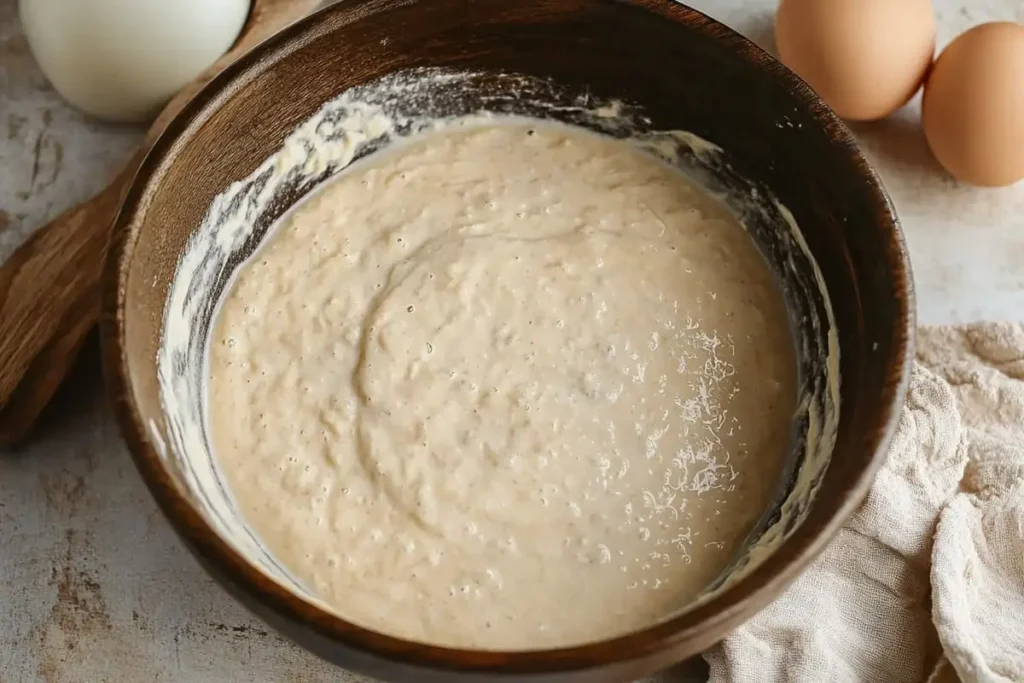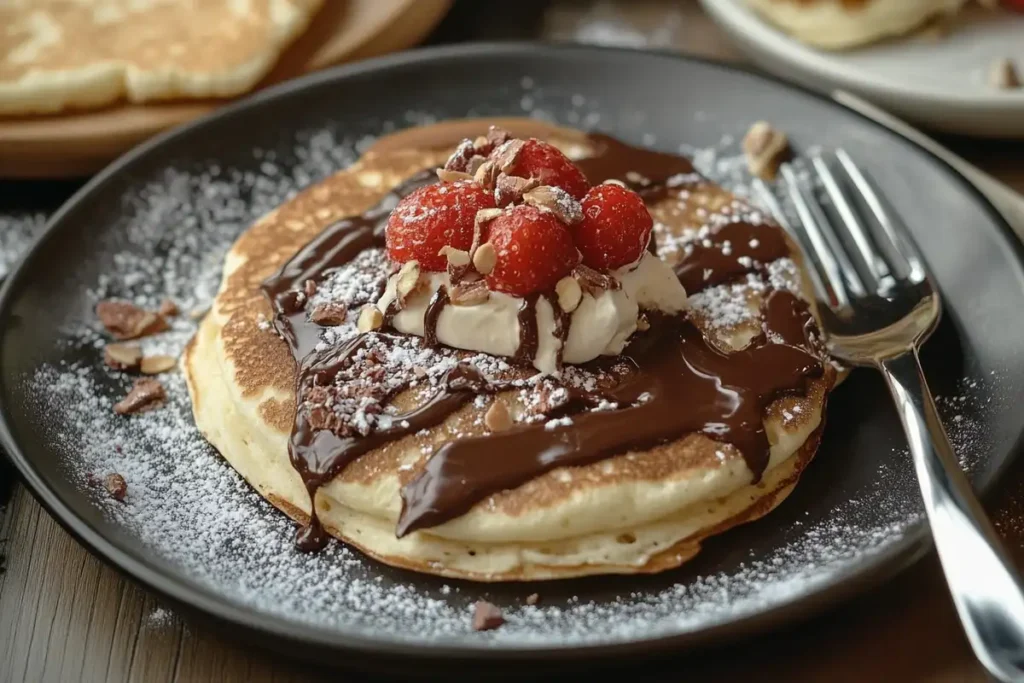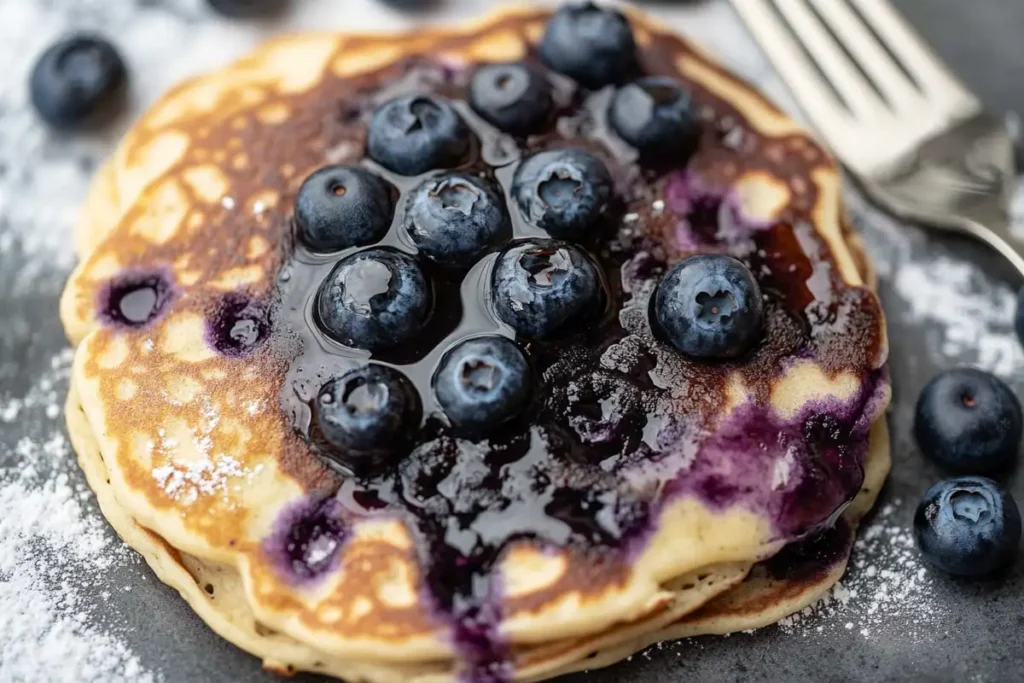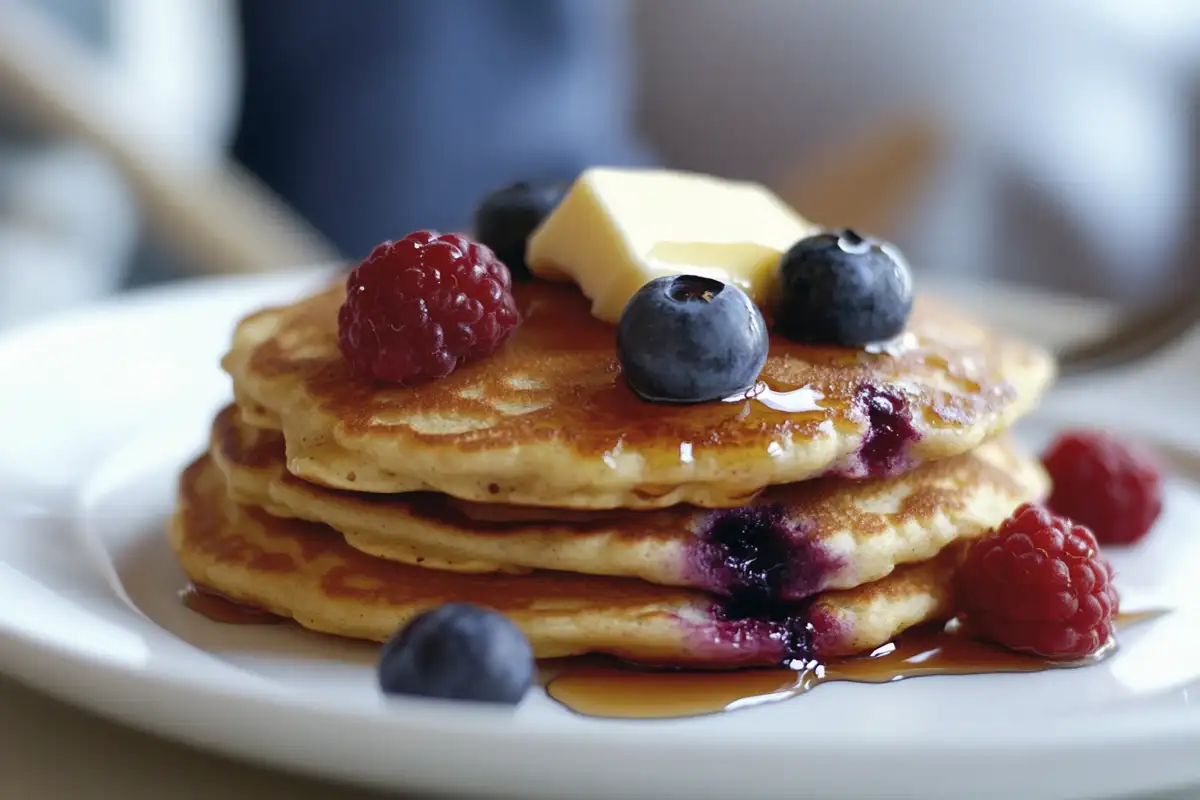Introduction to Gluten-Free Sourdough Discard Pancakes
Pancakes have long been a breakfast favorite, but the classic recipe often falls short for those navigating a gluten-free lifestyle. Enter gluten-free sourdough discard pancakes! These pancakes solve the problem of leftover sourdough discard and deliver a fluffy texture and a delightful tangy flavor. This article will guide you through everything you need to know—from understanding the magic of gluten-free sourdough discard to troubleshooting pancake problems and exploring creative variations. Whether you’re a seasoned baker or just starting, this guide will have you flipping perfect pancakes in no time.
Table of Contents
What are Gluten-Free Sourdough Discard Pancakes?
At their core, gluten-free sourdough discard pancakes are made using the leftover starter from a gluten-free sourdough starter. Instead of tossing the discard during feeding, it gets repurposed into something truly delicious. The result? Pancakes with a subtle tang, a tender crumb, and zero gluten.
Why Use Sourdough Discard in Pancakes?
Sourdough discard isn’t just about reducing food waste—though that’s a big perk. Thanks to the natural fermentation process, it also adds complexity to the pancake flavor. The acidity from the sourdough helps tenderize the pancake batter, resulting in a fluffy and soft texture. Plus, it’s packed with gut-friendly bacteria from fermentation.
Who Can Benefit from Gluten-Free Pancakes?
These pancakes are perfect for anyone following a gluten-free diet—whether due to celiac disease, gluten intolerance, or personal preference. But honestly, they’re so delicious that even those without dietary restrictions will enjoy them.
For those curious about the health benefits of sourdough fermentation, you can check out this detailed resource on the Benefits of Sourdough Fermentation for Gut Health.
Understanding Gluten-Free Sourdough Discard
What is Sourdough Discard?
At its simplest, sourdough discard refers to the portion of sourdough starter that is removed during the feeding process. It is done to maintain balance and prevent the starter from becoming overly acidic. In gluten-free sourdough discard, the starter uses gluten-free flour like rice flour, sorghum flour, or buckwheat flour.
Discard might sound like waste, but it’s far from it. It’s rich in active cultures, mild tanginess, and beneficial bacteria. Instead of throwing it away, using it in recipes like gluten-free sourdough discard pancakes transforms it into something delicious and resourceful.
How is Gluten-Free Sourdough Discard Different from Regular Discard?
The key difference lies in the flour. While traditional sourdough discard is made with wheat-based flour, gluten-free sourdough discard relies on naturally gluten-free flour. These flours have unique properties:
- They may require slightly different hydration levels.
- They have a lighter, sometimes grittier texture.
- They need careful handling to achieve a similar elasticity.
Despite these differences, both discard types bring the same fermented flavor and beneficial microbes to pancake batter.
Is Sourdough Discard Safe for Gluten-Intolerant Individuals?
Absolutely! As long as your sourdough starter was built and maintained exclusively with gluten-free flour, the discard will remain safe for those with gluten intolerance or celiac disease. However, cross-contamination can be an issue, so ensure your tools, workspace, and ingredients are all certified gluten-free.
How to Store Gluten-Free Sourdough Discard Properly
Proper storage ensures your discard stays fresh and usable:
- Short-Term: Keep it in a sealed container in the refrigerator for up to 7 days.
- Long-Term: Freeze discard in an airtight container for up to 3 months.
When you’re ready to make gluten-free sourdough, discard the pancakes, thaw them, and bring them to room temperature before mixing them into the batter.
For those who want to explore more about gluten-free flours and their unique properties, this resource on the Guide to Gluten-free Flours is a must-read.
Essential Ingredients for Gluten-Free Sourdough Discard Pancakes
Key Ingredients for a Perfect Batter
A good pancake starts with the right ingredients. When it comes to gluten-free sourdough discard pancakes, every component plays a crucial role:
- Gluten-Free Sourdough Starter Discard: The hero ingredient adds depth of flavor and slight acidity.
- Gluten-Free Flour Blend: A mix of rice flour, tapioca starch, and potato starch works wonders for texture.
- Eggs: These provide structure and help hold the batter together.
- Leavening Agents: Baking soda or baking powder gives the pancakes a light and airy texture.
- Milk or Dairy-Free Alternatives: Adds moisture to the batter. Almond milk, oat milk, or coconut milk are great alternatives.
- Oil or Melted Butter: For richness and a non-stick cooking experience.
- Sweetener: A touch of sugar, honey, or maple syrup balances flavors.
Optional Add-ins for Flavor and Texture
Get creative! Add-ins can elevate your gluten-free sourdough pancakes from ordinary to extraordinary:
- Fruits: Blueberries, bananas, or grated apples.
- Spices: Cinnamon, nutmeg, or vanilla extract.
- Nuts and Seeds: Chopped walnuts, almonds, or chia seeds.
Ingredient Substitutions for Allergies or Preferences
Dietary restrictions? No problem!
- Egg-Free: Use flax eggs or chia eggs.
- Dairy-Free: Opt for plant-based milk and coconut oil.
- Sugar-Free: Use natural sweeteners like stevia or monk fruit.
Why Ingredient Quality Matters
High-quality, gluten-free ingredients ensure better texture, flavor, and nutritional value. Poor-quality flour blends can result in gritty or dense pancakes, so choose trusted brands.
Always double-check labels for gluten-free certification to avoid accidental gluten exposure when shopping for ingredients.
Step-by-Step Recipe for Gluten-Free Sourdough Discard Pancakes
Preparation Time and Equipment Needed
Before diving in, let’s set the stage for a seamless pancake-making experience. Here’s what you’ll need:
- Preparation Time: 10 minutes
- Cooking Time: 15 minutes
- Total Time: 25 minutes
- Equipment: Mixing bowls, whisk, non-stick skillet or griddle, spatula, and measuring cups
Mixing the Batter

Start by combining your gluten-free sourdough discard with the wet ingredients: eggs, milk (or dairy-free alternative), and melted butter or oil. Whisk until smooth. Then, gradually fold in the gluten-free flour blend, baking soda, and sweetener. Avoid over-mixing—the batter should be slightly thick but pourable.
Pro Tip: Let the batter rest for 5–10 minutes. It allows the gluten-free flour to hydrate properly, resulting in softer pancakes.
Resting the Batter (Importance of Hydration Time)
Resting the batter isn’t just a suggestion—it’s crucial. The flour absorbs the liquid during this time, and the sourdough discard works its magic, enhancing texture and flavor. Skipping this step may leave you with gritty pancakes.
Cooking the Pancakes to Perfection

- Heat a non-stick skillet or griddle over medium heat.
- Lightly grease the surface with butter or oil.
- Pour 1/4 cup of batter onto the skillet for each pancake.
- Cook until bubbles form on the surface and the edges look set (around 2–3 minutes).
- Flip and cook for an additional 1–2 minutes until golden brown.
Pro Tip: Maintain consistent heat to avoid undercooked or burnt pancakes.
Serving Suggestions
Plate up your golden beauties and get creative with toppings:

- Classic Style: Maple syrup and fresh berries
- Savory Twist: Avocado slices and a sprinkle of sea salt
- Indulgent Treat: Chocolate chips and whipped cream
These gluten-free sourdough discard pancakes are best served warm but can also be stored in the fridge for up to 3 days or frozen for future breakfasts.
For additional pancake-cooking insights, check out Tips for Cooking Perfect Pancakes.
Tips for Perfect Gluten-Free Sourdough Pancakes Every Time
Consistency of the Batter
The perfect pancake batter should be thick yet pourable. If it’s too thin, add a tablespoon of gluten-free flour blend. Too thick? A splash of milk will do the trick.
Temperature and Cooking Surface Tips
- Always preheat your skillet or griddle before pouring the batter.
- Medium heat is the sweet spot. High heat can burn the pancakes, while low heat results in uneven cooking.
- Test the skillet’s readiness by sprinkling a few drops of water—if they dance and evaporate quickly, it’s ready!
Flipping Techniques for Light and Fluffy Pancakes
Ah, the art of the flip! Wait until bubbles form on the pancake’s surface and the edges firm up. Slide your spatula underneath and flip it over with a confident wrist motion. Avoid pressing down on the pancake—it’ll deflate all that fluffiness!
Storage and Reheating Tips
- Refrigerate: Store leftover pancakes in an airtight container for 3 days.
- Freeze: Lay pancakes flat on a baking sheet, freeze them, and stack them in a freezer bag. They’ll keep for up to 3 months.
- Reheat: Warm pancakes in a skillet over low heat or pop them in the toaster.
Adjusting for Altitude or Humidity
Baking at high altitudes or in humid conditions? Adjust your liquid content slightly. A tablespoon of less or more milk can significantly affect the batter’s consistency.
These simple yet effective tips ensure that every batch of gluten-free sourdough discard pancakes turns out light, fluffy, and irresistible.
Troubleshooting Common Pancake Issues
Why Are My Gluten-Free Pancakes Rubbery?
Ah, the dreaded rubbery pancake! The most common culprits are overmixing the batter and using too much liquid. Gluten-free flour blends are delicate, and excessive stirring can make the pancakes dense and chewy.
Quick Fixes:
- Stir the batter gently until the ingredients are combined.
- Ensure your gluten-free sourdough discard pancake batter isn’t overly runny. If needed, add an extra tablespoon of gluten-free flour blend.
Why Are My Pancakes Falling Apart?
If your pancakes crumble or break apart when flipping, it’s often due to insufficient binding agents or flipping them too early. Gluten-free pancake batter lacks the elasticity that gluten provides, so it needs extra care.
Quick Fixes:
- Add an extra egg or a tablespoon of ground flaxseed mixed with water.
- Be patient! Wait until bubbles form and edges firm up before flipping.
How to Adjust Batter for Desired Texture
Getting the perfect texture requires trial and error. If your pancakes are too dense, add a splash of milk to thin out the batter. Too flat? Add a pinch of baking powder or baking soda.
Common Gluten-Free Pancake Mistakes and Fixes
- Problem: Pancakes are too gummy.
- Fix: Cook them a little longer on lower heat.
- Problem: The batter spreads too thin.
- Fix: Add a spoonful of gluten-free flour blend.
- Problem: Pancakes taste too sour.
- Fix: Reduce the amount of sourdough, discard it, and balance flavors with a little sweetener.
Understanding the Role of Resting Time
Skipping the batter’s resting period is another common mistake. Hydrating gluten-free flours ensures the batter holds together better during cooking.
With these troubleshooting tips, your gluten-free sourdough discard pancakes will consistently turn out light, fluffy, and picture-perfect!
Creative Variations of Gluten-Free Sourdough Discard Pancakes
Savory Gluten-Free Sourdough Pancakes
Who says pancakes have to be sweet? On the contrary, savory pancakes are an absolute game-changer. For instance, add shredded cheese, diced green onions, or chopped spinach to the batter. Not only that, but you can also serve them with a dollop of sour cream or creamy avocado slices. As a result, you’ll have an indulgent brunch treat that’s both satisfying and packed with flavor. So, why not give savory pancakes a try?
Savory Add-in Ideas:
- Grated zucchini
- Sun-dried tomatoes
- Fresh herbs like parsley or chives
Sweet Gluten-Free Pancakes with Fruits or Chocolate Chips


Sweet variations are always a hit! In fact, they’re a surefire way to please any crowd. For example, directly mix fresh fruits like blueberries or sliced bananas into your pancake batter. Additionally, toss in a handful of chocolate chips for a truly decadent treat. As a result, every bite will burst with sweetness and delightful texture. So, why not indulge your sweet tooth with these delicious options?
Sweet Add-in Ideas:
- Raspberries or strawberries
- Dark chocolate chunks
- Coconut flakes
Seasonal Pancake Ideas (e.g., Pumpkin Spice, Cinnamon Apple)
Take advantage of seasonal ingredients to elevate your pancakes. In the fall, add pumpkin puree and a dash of cinnamon. For winter mornings, a sprinkle of nutmeg and grated apple works wonders.
Seasonal Flavors to Try:
- Pumpkin spice pancakes with maple syrup
- Apple cinnamon pancakes topped with caramel drizzle
- Lemon zest pancakes with fresh whipped cream
Vegan Variations of Gluten-Free Pancakes
Want to keep it vegan? Replace eggs with flax eggs (1 tbsp ground flaxseed + 3 tbsp water = 1 egg) and use plant-based milk like almond or oat milk. Coconut oil works beautifully as a butter substitute.
Experimenting with Toppings and Syrups
Pancake toppings are where creativity truly shines. Here are some delightful options:
- Classic maple syrup and butter
- Fresh fruit compote
- Nut butter drizzle
- Coconut yogurt and granola
The versatility of gluten-free sourdough discard pancakes ensures that they never get boring. With a little creativity, each batch can feel brand new!
Health Benefits of Gluten-Free Sourdough Pancakes
Nutritional Advantages of Gluten-Free Pancakes
While traditional pancakes often fall short in nutritional value, gluten-free sourdough discard pancakes offer unique health benefits. Thanks to the sourdough fermentation process, these pancakes contain probiotics that support gut health.
The gluten-free flour blends in these pancakes often include nutrient-rich flour such as brown rice, almond, or sorghum flour. These alternatives are naturally high in fiber, vitamins, and minerals.
Gut Health and Sourdough Fermentation
One of the standout benefits of using gluten-free sourdough discard is its probiotic content. During fermentation, natural bacteria in the starter break down sugars and starches, making the final product easier to digest.
This fermentation can reduce inflammation and improve digestion for individuals with mild gluten sensitivities. Plus, the probiotics contribute to a healthier gut microbiome, which is linked to better overall health.
Low Glycemic Index and Blood Sugar Benefits
Compared to traditional pancake recipes loaded with refined sugars and flour, gluten-free sourdough discard pancakes have a lower glycemic index. It means they cause a slower, more controlled rise in blood sugar levels, making them a better option for those monitoring their glucose intake.
Reduced Food Waste
Let’s not forget the environmental benefit! Using gluten-free sourdough discard minimizes food waste by repurposing an ingredient that might otherwise be tossed out. It’s a win for your health and the planet.
Incorporating these pancakes into your diet satisfies your taste buds and supports your body with wholesome, natural ingredients.
FAQs about Gluten-Free Sourdough Discard Pancakes
Is sourdough discard gluten intolerance safe?
Yes, gluten-free sourdough discard is perfectly safe for individuals with gluten intolerance or celiac disease, provided it’s made exclusively with certified gluten-free flour. Cross-contamination is a risk, so ensure clean tools and surfaces during preparation.
How often should I feed a gluten-free sourdough starter?
Ideally, a gluten-free sourdough starter should be fed every 24 hours if kept at room temperature. If stored in the refrigerator, feeding once a week is sufficient. Regular feeding keeps the starter active and prevents spoilage.
Can you do anything with sourdough starter discard?
Absolutely! Besides pancakes, gluten-free sourdough discard can be used in waffles, muffins, flatbreads, and even pizza crusts. Its tangy flavor and leavening properties make it incredibly versatile.
Why are my gluten-free pancakes rubbery?
Rubbery pancakes are usually caused by overmixing the batter or using too much liquid. Stir gently until the ingredients are just combined, and avoid excessive whisking.

